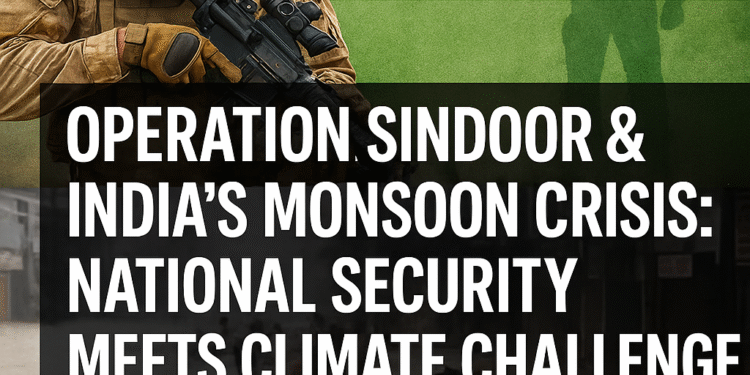The Indian government and security forces are dealing with a big challenge. They must fight terrorism and severe monsoon floods at the same time. On June 29, 2025, the southwest monsoon hit the whole country early, as the India Meteorological Department reported.

This unprecedented monsoon activity has caused historic floods in Rajasthan and other places. The security forces are working hard to respond. The Parliament debates how to tackle both terrorism and natural disasters together.
Key Takeaways
- India faces dual challenges of terrorism and monsoon floods.
- The southwest monsoon arrived early, causing widespread flooding.
- Parliament is debating national security and disaster response.
- A complete strategy is needed to address these challenges.
- The security forces are playing a key role in rescue and relief efforts.
A Nation Under Dual Siege
India faces threats from terrorism and natural disasters. The Parliament is deeply involved in discussions about Operation Sindoor and how to handle the recent floods.
Parliament Debates Amid Crisis
Parliament debates show the seriousness of the situation. They focus on Operation Sindoor and how to lessen the flood’s effects. A senior parliamentarian said, “We must work together to overcome these challenges.”
“We are not just fighting terrorism; we are also battling the fury of nature. Our response must be robust and multi-faceted.”
These talks stress the need for a strong plan against terrorism and natural disasters. The government is urged to improve its fight against terrorism and disaster management.
The Twin Challenges: Terrorism and Natural Disasters
India is fighting terrorism and natural disasters at the same time. The floods in Rajasthan, along the Chambal River, have caused a lot of damage. The Indian Army is leading a big rescue effort.
- The Chambal River flood in Rajasthan has affected several districts, with thousands displaced.
- The Army rescue operations in Rajasthan have been instrumental in saving lives and providing relief to those affected.
India’s security and disaster management are under a lot of pressure. To deal with these crises, a united and strong response is needed. This will help keep the country’s people safe and secure.
Understanding Operation Sindoor: India’s Bold Security Initiative
In 2025, the Indian government started Operation Sindoor. This move marked a big change in how India fights terrorism. It’s a key part of India’s plan to keep its borders safe, mainly from threats from Pakistan.

Origins and Objectives
Operation Sindoor was created to fight back against growing terrorism. Its main goal is to make the borders safer. It uses new military strategies and better spy work.
This operation works by combining efforts from the army, air force, and spy agencies. India wants to build a strong defense system. This system will help fight the tough challenges of terrorism.
Strategic Importance in 2025
In 2025, India faced big security challenges. Tensions at the borders were high, and terrorist acts were on the rise. Operation Sindoor was made to tackle these problems directly.
Operation Sindoor shows India’s strength and determination to stop terrorists. It shows India’s commitment to its people and keeping the region stable.
Key Military Components
Operation Sindoor has several important parts:
- Advanced surveillance systems to watch the borders
- Special forces for fighting terrorism
- Units for gathering spy info on terrorists
- Teams ready to act fast on new threats
By using all these parts, Operation Sindoor is a full plan to fight terrorism. It makes India’s security better in 2025 and for years to come.
Operation Sindoor India 2025 Rajasthan Flood Army Deployment Monsoon Flooding In Focus
The Indian Army’s Operation Sindoor was a key response to the severe monsoon flooding in Rajasthan. It showed the military’s ability to help in disaster relief.
Timeline of Operation Sindoor
Operation Sindoor started on August 10, 2025, due to the flooding in Rajasthan. It had a multi-faceted approach, including rescue, medical aid, and essential supplies.
- August 10, 2025: Operation Sindoor launched.
- August 12, 2025: Initial rescue teams deployed.
- August 15, 2025: Medical aid camps established.
- August 18, 2025: Relief supplies distributed.
Coordination Between Security Forces
The success of Operation Sindoor came from the teamwork between the Indian security forces. The Army, Navy, and Air Force worked together for rescue and relief.
| Branch | Role |
|---|---|
| Indian Army | Ground rescue operations, relief supply distribution. |
| Indian Navy | Rescue operations in flooded areas, medical aid. |
| Indian Air Force | Aerial surveillance, airlift of relief supplies. |
As General Manoj Pande, Chief of the Army Staff, said, “Operation Sindoor shows the Indian Army’s dedication to saving lives and easing suffering during disasters.”
“The Indian Armed Forces have always been ready to help the nation in crisis. Operation Sindoor is a great example of our commitment and ability.”
The impact of Operation Sindoor was huge, saving thousands of lives and distributing millions of dollars in relief. It showed the value of teamwork and the military’s role in disaster relief.
The Rajasthan Flood Crisis: Nature’s Fury Unleashed
Unprecedented rainfall in July 2025 shattered historic records, leading to severe flooding in Rajasthan. The state’s disaster management agencies, including the State Disaster Response Force (SDRF), have been actively involved in relief efforts.
Chambal River Overflow: Ground Zero
The Chambal River overflowed its banks, causing significant flooding in districts like Dholpur. The overflow has been identified as a major contributor to the flood crisis, with the river’s waters inundating nearby villages and agricultural lands.

Historic Rainfall Records Shattered
July 2025 saw record-breaking rainfall in Rajasthan, with some areas receiving over 300% of their average July rainfall. This unprecedented downpour has put a strain on the state’s infrastructure and disaster response mechanisms.
Most Affected Regions
The districts most affected by the flooding include Dholpur, Karauli, and parts of Bharatpur. These regions have seen significant damage to homes, infrastructure, and agriculture, with thousands of people displaced.
The SDRF and other state agencies have been working tirelessly to provide relief to those affected. Their efforts include evacuating people to safer areas and providing essential supplies.
Army to the Rescue: Heroism Amid Chaos
The Indian Army showed great courage and strength during the monsoon floods in Dholpur and nearby areas. As the floods hit Rajasthan hard, the Army quickly stepped in. They provided vital help to those trapped.
Rescue Operations in Dholpur and Surrounding Areas
The Indian Army worked hard to rescue people in Dholpur and nearby places. They helped people leave their flooded homes and gave them food and shelter. The Army focused on helping the most at-risk groups, like the elderly and kids.
In Dholpur, the Army saved over 500 people. They used helicopters and boats to reach those stranded. The Army worked fast and with great care to help those in need.
“The Indian Army’s rescue efforts in Dholpur were a light of hope for those hit by the floods. Their selfless work and commitment show the country’s strong spirit of resilience and courage.”
Equipment and Resources Deployed
The Indian Army used many tools and resources for their rescue work in Dholpur and nearby. They had:
- Helicopters for aerial rescue and medical evacuation
- Rescue boats for navigating flooded areas
- Emergency medical kits and personnel
- Food and water supplies for those stranded
| Equipment/Resources | Quantity Deployed | Purpose |
|---|---|---|
| Helicopters | 5 | Aerial rescue and medical evacuation |
| Rescue Boats | 20 | Navigating flooded areas |
| Emergency Medical Kits | 100 | Providing medical aid |
Challenges Faced by Rescue Teams
Even with their best efforts, the rescue teams faced big challenges. These included tough terrain, bad weather, and hard logistics. They had to go through flooded areas, often in dangerous conditions, to find those in need.
The Army’s ability to adapt and stay strong was key. It helped them overcome these obstacles and get aid to those who needed it most.
Monsoon 2025: A Pan-India Flood Emergency
India is facing a severe flood emergency in 2025. The monsoon rains have caused widespread flooding across the country. This has disrupted lives and livelihoods on a massive scale.
Assam’s Annual Battle Intensifies
Assam, known for its annual floods, faced a tougher challenge in 2025. The Brahmaputra River and its tributaries overflowed. This flooded vast areas of agricultural land and displaced thousands.
The state’s flood management was stretched to its limits. Emergency services worked non-stop to rescue those stranded by the rising waters.

The situation in Assam was made worse by water releases from upstream dams. This shows the need for better water management coordination between states during the monsoon.
Gujarat, Himachal, and Bihar: States Under Water
States like Gujarat, Himachal, and Bihar also faced severe flooding. In Gujarat, the rains caused urban flooding in cities like Ahmedabad and Surat. This paralyzed daily life.
Himachal Pradesh saw landslides and flash floods that damaged infrastructure and isolated villages. Bihar’s Ganges and tributaries overflowing affected millions of people.
| State | Affected Districts | Estimated Damage (in Crores) |
|---|---|---|
| Assam | 15 | 1000 |
| Gujarat | 10 | 800 |
| Himachal Pradesh | 8 | 500 |
| Bihar | 12 | 1200 |
Economic Impact of Widespread Flooding
The floods have had a big economic impact. Agriculture, a key sector, suffered greatly. Crops were destroyed, and livestock were lost, affecting farmers and rural communities.
Infrastructure damage, including roads and bridges, added to the economic burden.
“The floods have not only caused immediate destruction but also pose long-term challenges for the affected regions. The economic recovery will take time, and it’s vital that we implement measures to mitigate the impact of future floods.” –
Dr. K. K. Singh, Climate Expert
The total economic loss is estimated to be in the thousands of crores. The central and state governments have allocated significant funds for relief and rehabilitation. The floods have also highlighted the need for better disaster preparedness and infrastructure resilience.
The Indian Army’s Dual-Front Challenge
The Indian Army faces a tough task today. It must fight terrorism and natural disasters at the same time. This means balancing its efforts to stop terrorists and help in disasters.
Balancing Counter-Terrorism and Disaster Relief
The Army must keep the country safe and help in emergencies. Counter-terrorism operations need careful planning to stop threats. Disaster relief needs quick action to save lives and help those in need.
“The ability of the Indian Army to multitask and adapt to different scenarios is a testament to its strength and resilience.” Defense experts say the Army’s skill in both areas is key to keeping the country stable.
Logistical Challenges of Simultaneous Operations
Running operations at the same time is hard. The Army must make sure both its security and relief teams have what they need. This requires careful planning and teamwork to keep everything running smoothly.
- Resource allocation for dual operations
- Coordination between different units
- Maintaining operational readiness
Quick response to emergencies is also a big challenge. Efficient logistics are key to the Army’s success in facing these challenges.
Coordination with Civil Authorities
Working well with local governments is essential. The Indian Army teams up with them to handle crises together.
“The synergy between the military and civil administration is critical in reducing the effects of disasters and security threats.”
This teamwork makes the response efforts stronger.
By working closely with civil authorities, the Army can use more resources and skills to tackle both challenges.
Parliament’s Response to the Twin Crises
India’s Parliament is coming together to tackle security threats and monsoon disasters. Debates show the need for a strong national plan. This plan must address the complex challenges we face.

Key Points from Recent Security Debates
Security talks in Parliament have brought up key points. Concerns about terror near the Line of Control (LoC) are a big issue. Lawmakers want stronger counter-terrorism steps.
They also talked about India-Pakistan border tension and its impact on security. The focus is on better intelligence and teamwork among security groups. It’s also about tackling terrorism’s roots and engaging with communities to stop radicalization.
Political Divisions and Unity in Crisis
Despite differences, Parliament is united in crisis times. Lawmakers from all parties support emergency actions. This unity is key to a strong national response.
The spirit of working together is clear. Members stress the need to set aside political differences in emergencies. This unity will help shape India’s future crisis responses.
Policy Proposals and Emergency Measures
Parliament is discussing policies and emergency steps for security and environmental issues. They talk about enhanced flood defenses and better disaster plans. There’s a push for using technology for early warnings and better agency coordination.
They aim for a complete strategy, including immediate relief and long-term resilience. Parliament wants to boost India’s ability to handle future crises.
Climate Change and Security: The New Normal
India’s security is changing due to climate change. Natural disasters are happening more often and getting worse. This includes changes in the monsoon, rising temperatures, and more extreme weather.
Changing Monsoon Patterns and National Security
The monsoon season is key for India’s farming and economy. But, climate change is making it unpredictable. This leads to either severe droughts or floods.
In 2025, Rajasthan saw a lot of rain, causing floods and displacing people. This shows how hard it is for security forces to handle these situations. It also shows the need for better disaster management plans.
Urbanization’s Role in Amplifying Disasters
Fast urban growth makes disasters worse. Cities like Mumbai and Chennai are at high risk because of their location and poor infrastructure. Good urban planning and disaster prep are key to reducing disaster effects.
| City | Vulnerability Factor | Disaster Preparedness Measures |
|---|---|---|
| Mumbai | Coastal Location, Overcrowding | Early Warning Systems, Flood Defenses |
| Chennai | Coastal Location, Poor Drainage | Improved Drainage Systems, Public Awareness Campaigns |
| Delhi | Heat Island Effect, Air Pollution | Green Initiatives, Heatwave Preparedness Plans |
Preparing for Future Compound Crises
India needs a strong plan to face these challenges. This includes better disaster prep, climate-resilient buildings, and awareness campaigns. It’s important to include climate security in national defense plans.
By understanding how climate change, urban growth, and security are linked, India can prepare better. This means working together between government, security, and local communities to make the country stronger.
Redefining India’s Security Paradigm
Operation Sindoor shows India needs a new security approach. This should include fighting terrorism and protecting against climate disasters. The lessons from this operation are very important.
Lessons from Operation Sindoor
Operation Sindoor teaches us about the power of teamwork in security. It showed the value of enhanced intelligence gathering and inter-agency coordination. It also proved that knowing the local area and people is key.
The operation’s success came from quick action and being able to change plans. These are key for future security efforts.

Proposed Upgrades to Counter-Terror Protocols
After Operation Sindoor, India’s counter-terror plans need a boost. This means investing in advanced surveillance technology and better intelligence sharing. Also, fighting cyber terrorism is a growing concern.
Training for security teams should include realistic scenarios. This will help them be ready for any crisis.
Integrating Climate Security into Defense Planning
Operation Sindoor also shows the need to include climate security in defense plans. Climate change will make natural disasters worse. The Indian military must be ready to handle these.
This means creating plans to prevent disasters and improving early warning systems. Working with other countries to share knowledge and technology is also important.
By learning from Operation Sindoor, India can become more resilient. It can protect against terrorism and climate disasters, making a safer future for its people.
Disaster Readiness: Building National Resilience
India is tackling terrorism and natural disasters head-on. The recent floods in Rajasthan and other areas highlight the need for strong disaster management.
Enhancing Flood Defenses
After the 2025 monsoon, experts say India’s flood defenses need a big upgrade. They want to lessen the damage from future floods.
Key Measures for Improvement:
- Reinforcing existing dams and embankments
- Implementing advanced flood forecasting systems
- Creating flood plains and retention basins
Studies show that investing in flood defenses can save a lot of money. For example, the World Bank found that every dollar spent on disaster prevention can save up to $4 later on.
Early Warning Systems: Technology and Implementation
Good early warning systems are key to saving lives in disasters. India is using new tech like satellite imaging and AI to improve its systems.
| Technology | Application | Benefits |
|---|---|---|
| Satellite Imaging | Flood monitoring and prediction | Accurate and timely warnings |
| AI-Powered Models | Predictive analytics for flood risk | Enhanced preparedness and response |
These new tools are being added to India’s disaster management plan. This will help respond faster and more effectively.
Public Awareness and Community Preparedness
Getting the public ready for disasters is essential. India is running educational programs and drills to prepare citizens.
“Community preparedness is key to reducing the impact of disasters. By educating the public and conducting regular drills, we can save lives and reduce damage.” – Expert in Disaster Management
Initiatives include:
- Conducting regular community drills
- Developing educational materials for schools
- Creating public awareness campaigns
By focusing on these areas, India can improve its resilience. This will help it face natural disasters better.
Border Security Concerns in a Changing Environment
India’s border security is facing a new challenge: climate events. These events are changing the terrain and posing new challenges for border security forces.
India-Pakistan Relations Post-Operation Sindoor
Operation Sindoor has highlighted the India-Pakistan border dynamics. The operation aimed to improve security, affecting their relations. The ceasefire agreement in May 2025 is a key development, but tensions are high.
A recent report states, “The ceasefire has held, but the situation remains volatile, with both sides accusing each other of violating the agreement.”
“The ceasefire agreement is a step in the right direction, but sustained diplomatic efforts are needed to address the underlying issues.”
Impact of Climate Events on Border Security
Climate events are making border security harder. Rising temperatures and changing weather patterns alter the terrain. This makes it tough for security forces to monitor and protect the borders.
| Climate Event | Impact on Border Security |
|---|---|
| Flooding | Damages infrastructure, disrupts surveillance |
| Drought | Increases smuggling activities, strains resources |
| Extreme Weather | Complicates rescue and relief operations |
The changing climate is a security concern that needs a multi-faceted response. As border security concerns grow, India must adapt its strategies to meet these new challenges.

The india-pakistan ceasefire agreement may2025 has helped reduce tensions. But, the impact of climate events on border security is a pressing issue. It requires sustained cooperation and strategic planning to address.
Conclusion: Securing India’s Future on Multiple Fronts
Securing India’s future means tackling many challenges at once. These include terrorism, natural disasters, and climate change. Operation Sindoor shows India can handle two big crises at the same time. It proves the Indian Army is both flexible and strong.
Working hard on disaster management and border security is key. This helps make India safer. By being ready and working together, India can face threats better and stay safe.
India’s talks about national security show the need for more defense spending. They also highlight the importance of early warning systems and getting communities ready. The lessons from Operation Sindoor are very important for India’s future security plans.
By focusing on a strong future and national security, India can tackle terrorism, disasters, and climate change. This will make India a safer and more resilient place for everyone.
FAQ
What is Operation Sindoor, and what are its objectives?
Operation Sindoor is a key part of India’s fight against terrorism. It started in 2025. The goal is to stop terrorist threats, mainly from Pakistan, using smart military tactics and better intelligence.
How has the Indian Army responded to the floods in Rajasthan?
The Indian Army has been very important in helping people caught in the floods. They use helicopters and boats to rescue people. They also help in places like Dholpur.
What is the impact of the monsoon floods on India’s economy?
The floods of 2025 have hit India’s economy hard. They’ve damaged farms, buildings, and jobs in places like Assam, Gujarat, and Bihar. This has caused big losses.
How is the Indian government addressing the dual challenges of terrorism and natural disasters?
The government is fighting both problems at once. They’re boosting their fight against terrorism with Operation Sindoor. They’re also working together to deal with the floods.
What are the key lessons from Operation Sindoor for India’s security establishment?
Operation Sindoor shows the need for better ways to fight terrorism. It also teaches the importance of thinking about climate change in defense plans. These lessons help India face new security challenges.
How is climate change affecting India’s national security?
Climate change is a big threat to India’s safety. It’s changing the weather and causing more extreme events. India needs to be ready to manage these disasters.
What measures are being proposed to build national resilience to disasters?
To get better at handling disasters, India plans to improve flood protection and early warning systems. They also want to make people more aware and prepared for emergencies.
How are India’s relations with Pakistan influenced by Operation Sindoor?
Operation Sindoor is changing how India and Pakistan deal with their border. They’re focusing on stopping terrorism and managing the effects of climate change along the border.
What is the role of the SDRF in the flood relief efforts in Rajasthan?
The State Disaster Response Force (SDRF) is helping a lot in Rajasthan. They work with the Indian Army and others to help people affected by the floods.
How has the Parliament responded to the twin crises of terrorism and natural disasters?
The Parliament is talking a lot about these big problems. They’re sharing concerns and suggesting ways to solve them. There’s a growing agreement on the need for everyone to work together during crises.








